Ducati’s updated Panigale V4 S for 2022 brings with it new aerodynamics, ergonomics, engine, chassis and electronics. Have Ducati managed to improve the already excellent Panigale?
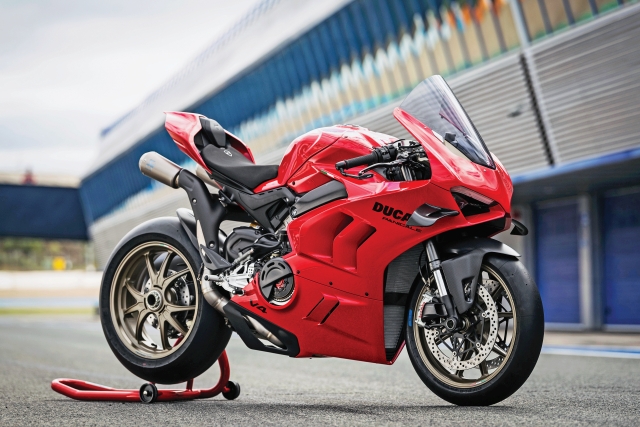
Story: Adam Child
Photography: Ducati – Alex Photo
Improving an already excellent bike is a difficult job. However, as Ducati inform us, ‘this is the most significant development since its birth’. The stop-watch does not lie. During exclusive consecutive testing with the 2021 and 2022 models, two testers joined official Ducati test-rider Michele Pirro on track. By the end of the day, one rider improved by 0.9 seconds, the second by 1.2 seconds, and Pirro by 0.5. In fact, Pirro was only three seconds slower than the lap-time set during race one in the highly competitive Italian Superbike Championship.
Ducati have chopped lap-times, especially so for less inexperienced riders, by improving the aerodynamic package, ergonomics, engine, chassis, and rider aids. Interestingly, Ducati staged a similar trick on the 2020 model, making it easier to ride than the previous Panigale, which we tested in Bahrain. We headed to Jerez in Spain to see if the new Panigale could live up to the expectations.
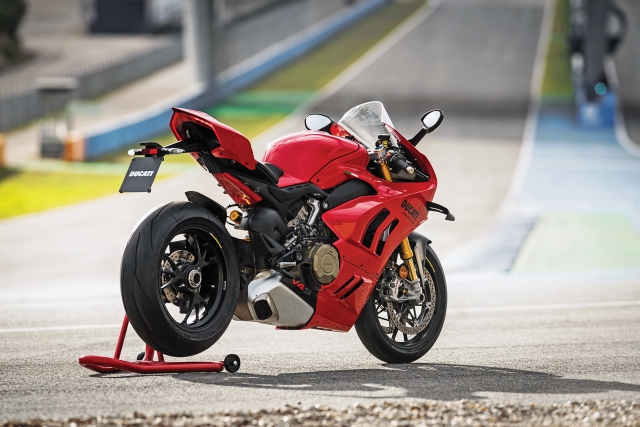
Ducati have revised the V4’s ergonomics, making it less physical and easier to ride, by creating a more supportive tank shape while increasing the size of its capacity by one litre. The seat (with two-tone colours on the “S” model) is flatter with greater control. Chassis-wise the swing-arm pivot point has been raised by four millimetres to reduce squat and the Öhlins NPX25/30 forks have new settings, softer springs, and five mm of more travel, taking their stroke to 125 mm.
The new ergonomics make life simpler for the rider, offering greater assistance when braking, moving on the bike, and hanging off mid-corner. Softening the suspension to give more movement and feeling is deliberately for “normal” track riders rather than professional superbike aces.
The changes in ergonomics are immediately evident even whilst leaving the Jerez pit-lane. The tank is wider, the seat is flatter and more grippy, and you feel more in the bike, more secure.
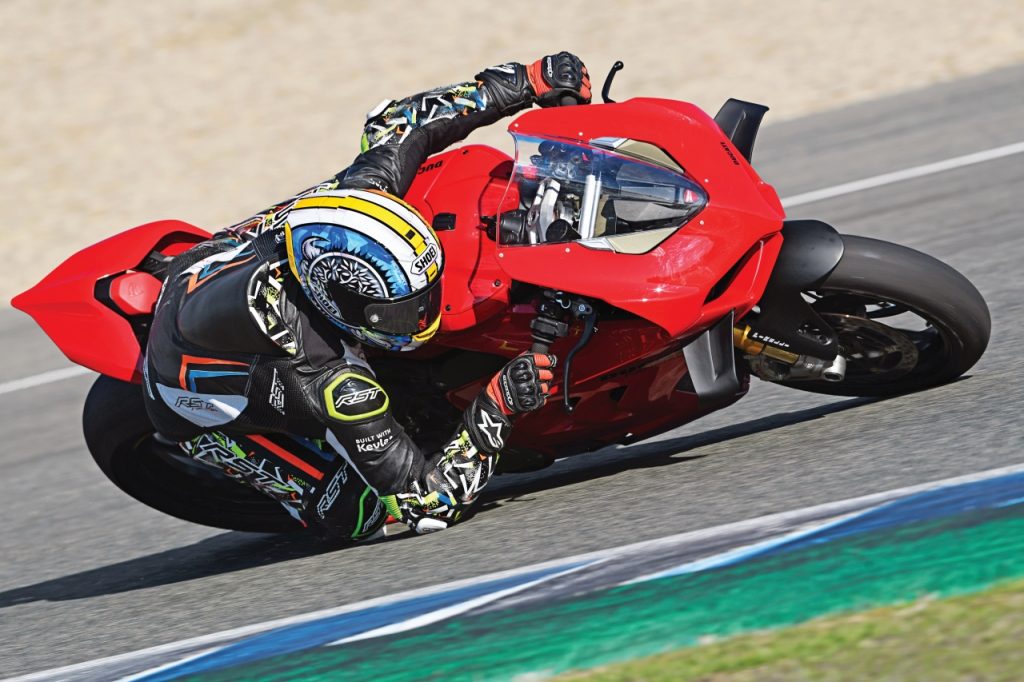
When braking devilishly late, you are no longer combating your bodyweight from sliding up the fuel-tank towards the top yoke. It is still physical, but not as much as before. Likewise, when you are hanging off the inside, elbow dragging on the track, the fuel-tank shape offers greater support and there is more grip from the seat.
Handling cannot just be characterized by mechanical grip and handling; electronics also come into play, especially when you have over 215 hp to work with. The modes come in their own as they change the Öhlins semi-active suspension. Each Evo mode has a pre-set setting, Brake Support, Front Fork, Shock Absorber, Steering Damper, Acceleration and Mid-corner. Changing from Race B Evo to Race A Evo, for example, adds more support to everything, with only the electronic steering damper remaining the same. Spring preload is still mechanically changed.
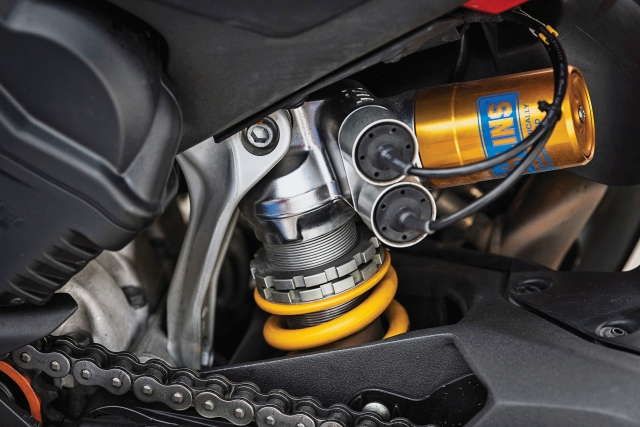
The disparity among the modes is evident but not extraordinary. However, the front end feeling on the 2022 bike is undoubtedly different from the 2021 model. You have more feel from the front Pirelli slick and you get more trust, which allows you to hold the brake later and deeper.
As always, you are dependent on the rider aids, even with minimal settings working in the background. In Full (which allows full torque in second and third gear) the Slide and TC light illuminates from time to time, but again you cannot feel the intervention; it is seamless.
The handling is superb, at times you must remind yourself this is a road bike, albeit an exotic and expensive one. I have never felt so much at home, with elbow-dragging lean angles.
The brakes remain the same: top-quality Brembo Monobloc Stylema R four-piston calipers with Bosch Cornering ABS EVO. Like the engine, Ducati did not need to improve this area of the motorcycle as the cornering ABS is class-leading. In Race modes, the rear brake does not have ABS, but was hardly used when pushing for lap-times.
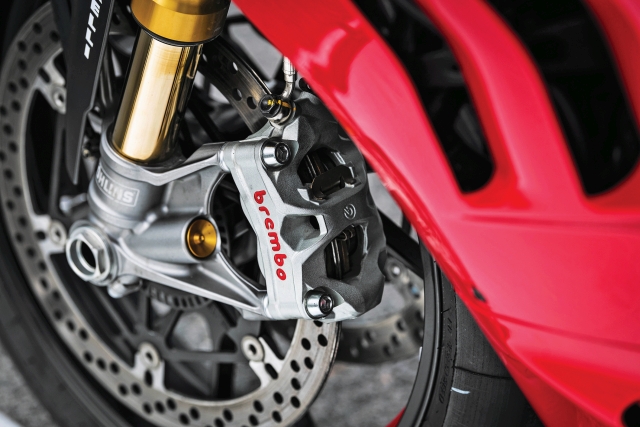
The improvement to the front end now allows you to make even more use of the excellent Brembo set-up. The revised ergonomics also make it less physical for the rider, allowing you to brake later with the same effort. The Brembo Stylema brakes with changeable engine brake strategies are hugely impressive. The aero-package also adds to stability when you make the initial grab of the lever as there is weight on the front. Watching MotoGP riders Johann Zarco and Jorge Martin braking for Turn One at Jerez was mesmerising. Each lap I thought they had left it too late, but they still made it.
Ducati have managed to force out a little more power from the Desmosedici Stradale V4. A new oil-pump and oil-circuit reduce power loss and, along with slight improvements in the exhaust, the 2022 model produces an extra 1.5 hp, now 215.5 hp at 13,000 rpm. With more over-rev, it also makes 2.5 hp more than it did at 14,500 rpm.
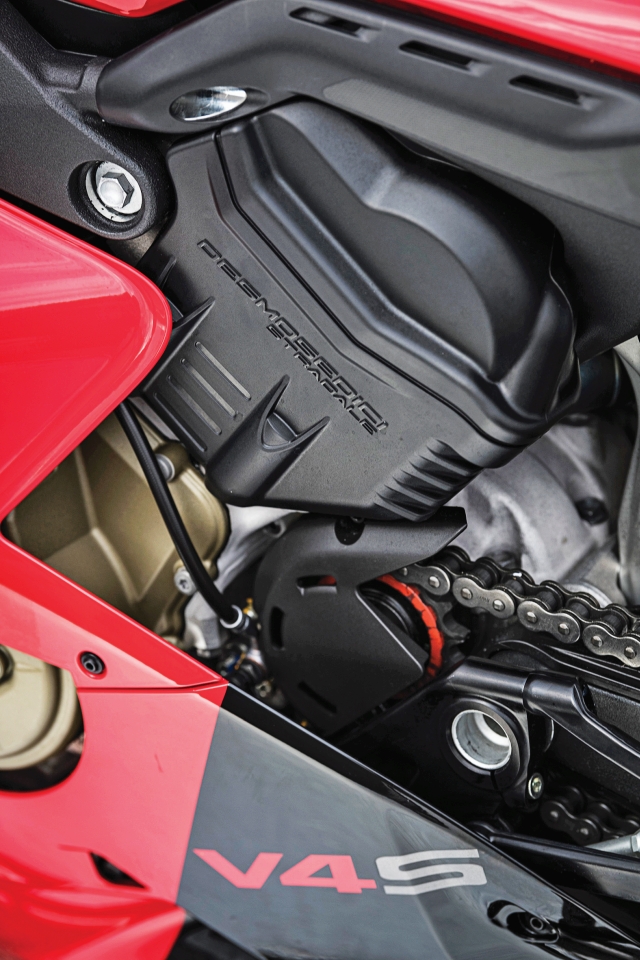
Torque-wise, the V4 delivers 123.6 Nm at 9,500 rpm, with 80 per cent of that peak figure delivered by 6,000 rpm. Peak output is a fraction down compared to the previous model (124 Nm) but if you can feel the difference, you should get a job as a Ducati test-rider.
More significant is a change in the gearing. Ducati have introduced a new gearbox with a longer first (11.6 per cent) and second (5.6 per cent) gear, plus a longer sixth gear (1.8 per cent). These new ratios are more race-focused, allowing the rider to use first in slower corners, for improved engine braking and acceleration. The taller sixth gear has allowed a five-kilometre increase in top speed and, for the road, should in theory drop the rpm slightly whilst touring, should you want to.
To make life easier, especially so for less experienced riders, Ducati have now introduced new electronics, including four power modes: Full, High, Medium, and Low. Full and Low are completely new for 2022, with Low reducing peak power to 150 hp, whereas Full unleashes all those lovely Italian horses, only limiting torque slightly in first gear. Each power mode has a different gear strategy, too. For example, torque is limited in the first three gears in High and Medium, but not in Full. Having the ability to tailor the torque for each gear is a first for the motorcycle industry.
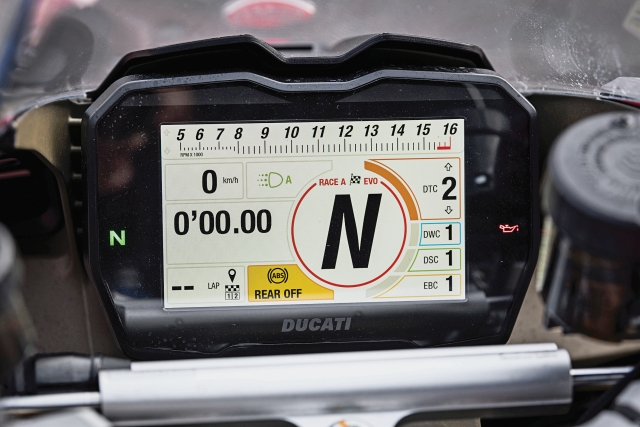
As standard, the V4 has Race A, Race B, Sport, and Street. Our test bike was fitted with the optional “Track Evo”, which adds to the standard Road and Track settings. Now you have Race A Evo, Race B Evo, Wet Evo, and Sport Evo and even a mode called “Jerez” (other tracks are also available). Track Evo changes the dash to give live lap-times and splits, a clear horizontal digital rev-counter, a large gear position indicator, and a visual “live” rider aid intervention display on the right side. If, while riding, you activate any of the multiple rider aids, say, slide control, it will change its display to colour on the dash.
The rider aids are so smooth, it is sometimes hard to feel them working, so the colour indicator on the new race dash layout is a very valuable instrument. Furthermore, all this technology is linked to a GPS unit which gives live lap-times and splits — it is like a real-life video game as you chase your best lap while watching the rider aids light up in colour as they do their thing.
These newly introduced rider aids dramatically change the engine performance and usability of the new 2022 Panigale, Track Evo especially. It is now even easier to tailor the set-up and electronic trim to exactly how you ride, the grip available, and conditions. Incidentally, the Evo system has been specifically designed to work with slick tyres or race wets.
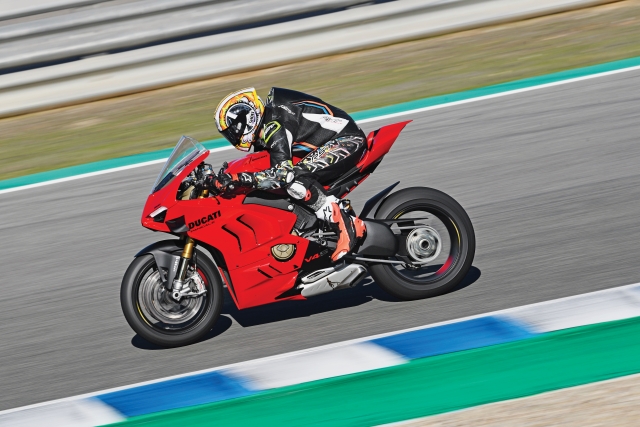
Jerez was unseasonably cold in the morning, which meant I opted for Race B Evo, maximum power, a smooth ride-by-wire throttle response, and limited torque in the first three gears, along with a plethora of rider aids set for slicks, along with the Öhlins Smart EC 2.0 semi-active suspension.
On lap one, even with “only” opting for the Race B Evo the Panigale is still shockingly fast. For the first few laps I am having to recalibrate my understanding. I then realise I have not seen the new, much larger gear change indicator flash yet. I thought I was revving the Panigale, but it wants more, all the way to 14,500 rpm. This is ridiculous; Jerez has never felt so tiny — and this is with limited torque in the first three gears and a “smooth” throttle.
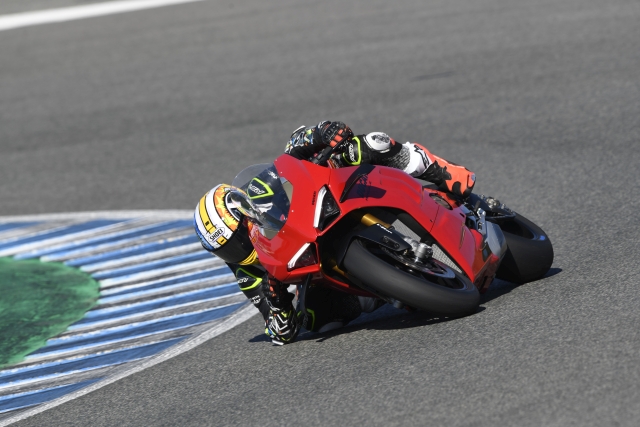
The recalibrated Stradale loves revs. It feels wrong to brutally rev a pricey, sexy, and desirable bike so much — but the bike loves it. The main straight is taken in fifth gear, then it is back to second or first for Turn One. As quickly as you can read this sentence, you can back-change without the clutch, even with the revs above 12,000 rpm, and there is no objection. With a longer first gear, it is more usable, too, not only giving faster acceleration out of slow turns, but helping to slow the bike into corners.
Upshifts are equally impressive: quick and effortless. For session one I opted for the standard shift but flicked over the gear position for a race shift in session two. Tapping on the up-and-down shifter feels as good or better than many pure race set-ups I have used.
Once up to speed with the track and slick tyres, I opted for Race A Evo, with less rider aid intervention and more aggressive power, plus Full, which only limits the torque a fraction in first gear. In Race A Evo, power is a little sharper, but not an enormous step more. The rider aids, although working more in the background, are clearly shown by the new dash, while the front wheel now lifts out of the last turn, hovering a few inches above the famous Spanish MotoGP racetrack.
Full power mode allows maximum torque in all gears, barring first, which is only limited a fraction. I was a little intimidated as I left pit-lane, but (minimal) lean-sensitive rider aids are still at hand and there is outstanding grip from the Pirelli slicks as well as an excellent chassis and downforce created by new wings. Full is more aggressive, especially in second gear, which, in turn, makes the V4 harder to ride. I found myself holding on more whilst exiting second-gear corners hard on the power — it is a tough workout but an incredible experience.
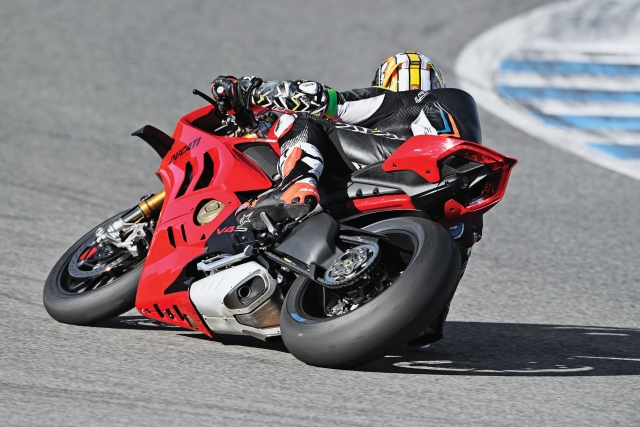
My lap-times did not jump forward with the more aggressive modes — in perfect conditions I opted for either Race A Evo or Race B Evo. With more track-time it might have been possible to reduce the rider aid intervention levels further and spend more time chipping away in Race A Evo. But that is the beauty of the new Panigale — it is so tweakable and adjustable, so easy to set up and optimize for you and the track you ride on.
To improve on an already excellent bike was an unbelievably tough task. Nevertheless, Ducati have not only made the new bike faster at the racetrack, they have also made it easier to ride — more so for those of us who have not raced at the global level. The improved ergonomics, braking, suspension, electronics, and aerodynamics all work together to make the Panigale more rideable than ever before. Ducati have not messed with a proven formula; the engine and looks are similar, the brakes are mechanically identical.
Ducati have basically made the Panigale for 2022 more accessible and easier to ride, which means you can push harder and for longer. Furthermore, this ease of use should transpose to the road; we shall have to wait and see.
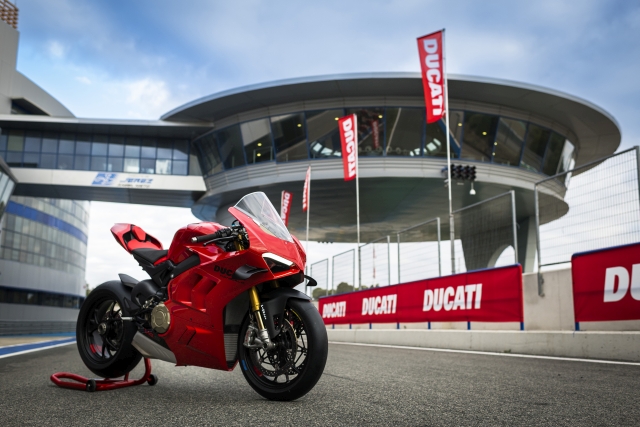
Questionably the world’s most desirable production bike is now even better, a stunning poster bike for 2022 which is race bike-like on track, but you do not have to be a professional to enjoy. Shame I shall probably never be able to afford one.


Leave a Reply